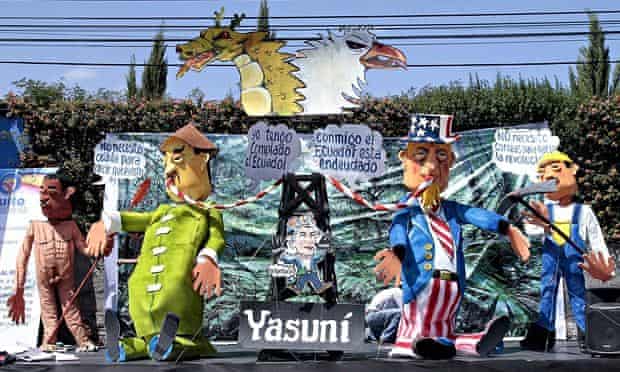Dolls representing the oil exploitation in the Yasuni Natural Park
Ecuador’s government was moving to install a power plant to exploit oil fields under the iconic Yasuni national park at the same time as pursuing a high-profile international scheme not to exploit the oil, according to government documents seen by the Guardian.
Plans to install the plant further undermine claims by the government that it was seriously pursuing the “Yasuni-ITT Initiative” – a pioneering scheme to leave the oil in the ground in return for financial compensation from international donors.
The Yasuni national park is one of the most biodiverse places on the planet and home to indigenous peoples, some living in what Ecuador’s constitution law calls “voluntary isolation.” The ground-breaking initiative, publicly endorsed by the government in 2007, was widely praised by green and human rights groups and had been seen around the world as a novel attempt to protect forest and people. It was formally abandoned by the government last August after just 0.37% of the financial target was received from donors.
But the existence of a behind-the-scenes plan in 2010 to build energy infrastructure to power a drilling operation there casts doubt on the government’s commitment to the Yasuni-ITT initiative.
“In my opinion, these documents show that the government was actually preparing the extraction of the oil at the same time that it was officially promoting the opposite,” says Carlos Larrea, from the University Andina Simón Bolivar, who worked as an adviser between 2007 and 2011 to the government’s team promoting the Yasuni-ITT Initiative.
Tiputini River and rainforest, Yasuni National Park, Amazon, Ecuador,
Tiputini River and rainforest, Yasuni national park. Photograph: Pete Oxford/Corbis
In February, the Guardian uncovered evidence that in 2009 the Ecuadorian government was negotiating a secret $1bn deal with a Chinese bank that would have allowed Chinese companies to explore the ITT and neighbouring fields for oil.
But the government vigorously denied the claims, saying the document describing the deal was “fraudulent”.
Ecuador’s ambassador to the UK, Juan Falconí Puig, said, “Yasuni was never up for negotiation,” and that the suggestion that the government was in negotiations with the Chinese “wrongly implies that Ecuador was never serious in making the scheme work.” He said the scheme was eventually dropped in 2013 with “a heavy heart”.
The new documents consist of a 17-page summary of an Environmental Impact Assessment (EIA) and Environmental Management Plan (EMP) for a proposed power plant and subtransmission lines, together with a letter from the environment ministry and state oil firm PetroEcuador to council members in the Aguarico district inviting them to a meeting on 26 March 2010 to discuss a draft version of the EIA.
The EIA summary’s introduction states: “Petroproduccion [then a PetroEcuador subsidiary] is launching the oil production project named Ishpingo, Tiputini and Tambococha, which involves the installation of a thermoelectric generator system and subtransmission lines to each one of the five oil well platforms, with a capacity of 76 megawatts thermal generation in order to supply electricity to the ITT fields.”
It continues: “The station will supply and distribute electricity via 69.2 kilovolts sub-transmission lines, which will permit operations at, and the extraction of oil from, the Tiputini Shell 1, Tiputini Minas 1, Tambococha 1, Ishpingo 2-4 and Ishpingo 3-1 well platforms.”
“All this shows that the decision to exploit ITT was taken from the beginning and that it was advancing in parallel with the initiative to leave the oil underground,” said Alexandra Almeida, from Ecuadorean NGO Acción Ecologica.
“This is one more evidence that plan B [to exploit the oil] was actually the only plan and they were keeping this information under the rug,” said Carlos Andres Vera, a journalist who has investigated the Yasuni issue extensively.
Yasuni park in Ecuador
Children swim in the shadow of oil pipelines in a river near Yasuni national park in Ecuador. Photograph: Eduardo Leon/Corbis
The EIA summary, which makes no mention of the Yasuni-ITT Initiative or the indigenous people in “voluntary isolation” or a supposedly “intangible zone” established to protect them, was written by a Quito-based consultancy called VVP, whose legal representative is named as Vinicio Valarezo Peña. Valarezo Peña, who previously worked for the environment ministry, told the Guardian that the EIA had been approved by the ministry and was “conducted in full compliance with all the applicable laws”.
The letter to the Aguarico councilors was signed by PetroEcuador representative Carmen Peralvo Guzman and environment ministry representative Carlos Villon Zambrano. Peralvo Guzman said she didn’t attend the 26 March meeting but she confirmed that there had been a plan to build power plants.
Sociologist Mesias Robalino is named in the PetroEcuador and environment ministry letter as the 26 March meeting’s “facilitator” and confirmed that he attended. Robalino said that the meeting focused more on how to exploit the ITT oil fields rather than the power plant itself.
In a statement a spokesperson for the environment ministry said that the process to obtain the environmental permits to build the power plant was begun in 2009 – by state oil company PetroAmazonas – but was subsequently abandoned.
“In 2009 Petroamazonas requested that the environment ministry begin the environmental regulation process for an electrical power plant in the Yasuni national park, within the framework of possible oil exploitation in the region. But given that it was to be located in a protected area, the project was rescinded and abandoned,” he said.
PetroEcuador declined to comment.
Despite the public promotion of the Yasuni-ITT Initiative by the government, there was always a “plan B”.
In March 2007, the energy ministry referred to leaving “the door open” to exploitation, and an agreement signed with the United Nations Development Programme in 2010 in which it agreed to establish a fund to collect donations acknowledged that Ecuador could “default” and decide “to initiate oil prospecting in the Yasuni ITT oil fields.”
The president, Rafael Correa, and other government representatives consistently maintained “plan B” was a back-up option in case insufficient compensation was raised – and that it concerned the Tiputini and Tambococha fields only, not Ishpingo.
“In 2008 there was an attempt to create a project called TT, that’s to say, to introduce the idea that the crude could be extracted from Tiputini and Tambococha,” says Alberto Acosta, former energy minister under Correa and one of his opponents in the 2013 presidential elections. “Ishpingo would not be subject to any such extraction.”
On 6 March 2010 – just two days before the letter to Aguarico’s council members about the power plant and exploiting all three fields – Ecuadorean newspaper Hoy reported Correa saying: “We would never want to use [plan B], but if necessary we will,” and that the plan “is now TT, not ITT.”
On 5 August 2011 another Ecuadorean newspaper, El Comercio, reported Correa saying studies for “plan B” were being carried out but the “intention is not to touch” Ishpingo. Crucially, the new document explicitly includes Ishpingo.
Almeida says the government continued to back the Yasuni-ITT initiative because it was politically difficult to drop. “Carrying on with the negotiating team and the initiative to leave the oil under the ground was only a strategy to avoid losing popularity ahead of the February 2013 [presidential] elections,” he said. “When the government abandoned it in August 2013 it lost popularity, as evidenced in the February 2014 local elections when Alianza Pais lost a huge number of local governments.”
Yasuni national park – a timeline
1989 Yasuni declared a Unesco biosphere reserve.
2007 Mounting pressure from environmentalists and scientists leads to president Rafael Correa to launch the Yasuni ITT initiative.
2008 Correa sets up a trust fund for the initiative.
2010 Ecuadorian government and the UN Development Programme agree to open an international trust fund. Initial donors include environmentalists (Al Gore), film stars (Leonardo DiCaprio, Ed Norton) and countries (Germany, Spain, France, Sweden and Switzerland).
July 2013 Correa forms a commission to evaluate the initiative, which concludes the funds raised are insufficient.
August 2013 Correa uses presidential executive order to officially liquidate ITT.
October 2013 UNDP trust agree to reinvest or return money to donors. To date US$2m returned so far.
May 2014 Ecuador National Electoral Council rejects petition for a referendum on opening Yasuni national park for oil exploration, citing too few valid signatures.
Nishad Karim
• This headline of this article was amended on 3rd July 2014. It had originally stated that the proposed power plant would be cited in the forest.

